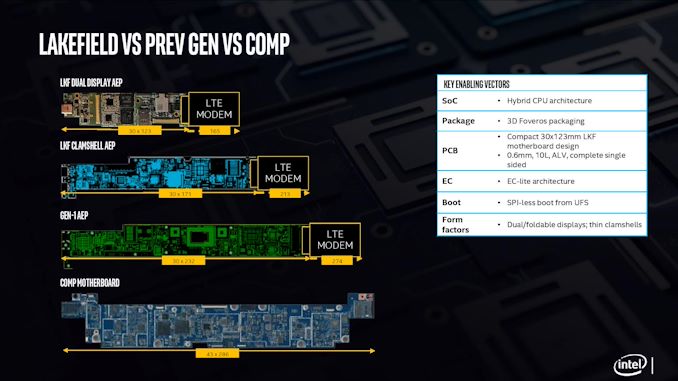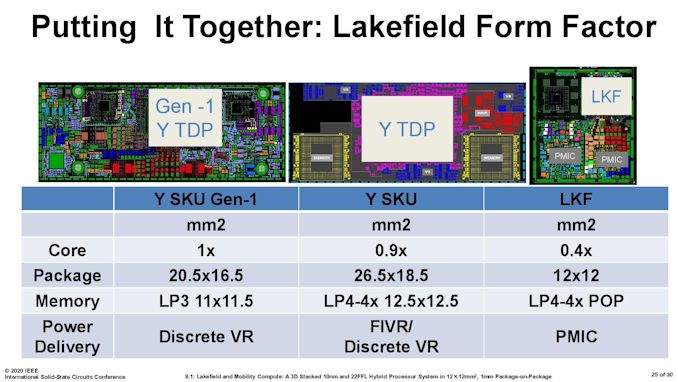The Intel Lakefield Deep Dive: Everything To Know About the First x86 Hybrid CPU
by Dr. Ian Cutress on July 2, 2020 9:00 AM ESTLakefield in Terms of Laptop Size
In a traditional AMD or Intel processor designed for laptops, we experience two to eight processing cores, along with some graphics performance, and it is up to the company to build the chip with the aim of hitting the right efficiency point (15 W, or 35/45 W) to enable the best performance for a given power window. These processors also contain a lot of extra connectivity and functionality, such as a dual channel memory controller, extra PCIe lanes to support external graphics, support for USB port connectivity or an external connectivity hub, or in the case of Intel’s latest designs, support for Thunderbolt built right into the silicon without the need for an external controller. These processors typically have physical dimensions of 150 square millimeters or more, and in a notebook, when paired with the additional power delivery and controllers needed such as Wi-Fi and modems, can tend towards the board inside the system (the motherboard) totaling 15 square inches total.

One of Qualcomm’s examples from 2018
For a Qualcomm processor designed for laptops, the silicon is a paired down to the essentials commonly associated with a smartphone. This means that modem connectivity is built into the processor, and the hardware associated with power delivery and USB are all on the scale of a smartphone. This means a motherboard designed around a Qualcomm processor will be around half the size, enabling different form factors, or more battery capacity in the same size laptop chassis.
With Intel’s new Lakefield processor design, the chip is a lot smaller than previous Intel implementations. The company designed the processor from the ground up, with as much included on the CPU as to not need additional chips on the motherboard, and to fit the dimensions similar to one of Qualcomm’s processors. Above is a slide showing how Intel believes that with an LTE modem included, a Lakefield motherboard can move down to 7.7 square inches, similar to a Qualcomm design. This leaves more room for battery inside a device.
When Intel compares it against its own previous low power CPU implementations, the company quotes a 60% decrease in overall board area compared to its first generation 4.5 W processors.
It is worth noting that for power delivery, Intel placed MIMCAPs inside the Lakefield silicon, much like a smartphone processor, and as a result it can get by on the power delivery implementation with a pair of PMICs (power management ICs). The reason why there is two is because of the two silicon dies inside – they are controlled differently for power for a number of technical reasons. If each layer within an active stacked implementation requires its own PMIC, that would presumably put an upper limit on future stacked designs – I fully expect Intel to be working on some sort of solution for this for it not to be an issue, however that wasn’t implemented in time for Lakefield.
For those that are interested, Lakefield’s PMICs are under the codenames Warren Cove and Castro Cover, and were developed in 2017-2018.












221 Comments
View All Comments
EthiaW - Tuesday, July 7, 2020 - link
How can we expect something that stingy on silicon area (don't have place for a single more large core) to compete with a snapdragon 9cx (likely with two Cortex-X1)or apple a14? Actually it has no edge over apple a12 from 2018 even the latter faces some 40% performance lost in x86 simulation.Wilco1 - Wednesday, July 8, 2020 - link
It doesn't even compete with the 18 month old 8cx... It will be interesting to see a side by side Book S review with benchmarks and battery life.serendip - Tuesday, July 14, 2020 - link
https://www.notebookcheck.net/Samsung-Galaxy-Book-...Here it is. It barely competes against the 8cx but gets almost half the battery life running at 5W TDP. Samsung is supposed to release an update to allow running at 7W but that would kill battery life even more.
Wilco1 - Wednesday, July 15, 2020 - link
Ouch... Thanks for that link!reggjoo1 - Tuesday, July 7, 2020 - link
Just manipulating the scheduler, won't be enough. They're gonna have to work on the governor more.808Hilo - Sunday, July 12, 2020 - link
Headline:Intel expanded its turd business!
We successfully, and at great cost, replicated the Atom processor and are only 10 years late with our consumer grade chip. The improvements are amazing: 1 slow processor supported by 3 superslow processors in a revolutionary new 4 processor die. The chip, designed for warheads, is exclusively down binned and handselected for exacting consumer standards. Support our military. Desining low performance is not cheap. Getting effed - Intel inside!
throAU - Monday, July 13, 2020 - link
So, unless this can compete with the iPad Pro processor of the day, I just don't see the market. Windows 10 on ultra portable tablet type devices already sucks. So your realistic choices are android and iOS. Android has a suite of decently performing, already existent SOCs on the market, likely at far less cost than intel will no doubt try to charge for this. And no AVX-512? Only a single performance core? I just don't see it working out.I would have thought they'd be far better off not neutering the Sunny Cove core, and working with Microsoft/others on an API for workload queuing to the relevant core for a relevant code fragment. Treat the performance core as you would any other co-processor. Use thread affinity to bind specific UI threads to it. I'm sure there are methods that could be used but no - in order to run on unmodified platforms (that suck for the market segment they are aiming at anyway) - they crippled it.
serendip - Tuesday, July 14, 2020 - link
Notebookcheck has a review comparing the Intel Lakefield and ARM models of the Galaxy Book S:mhttps://www.notebookcheck.net/Samsung-Galaxy-Book-...The results aren't pretty. For the same price of around $1000, the Lakefield version loses LTE in some markets, has equal or slightly less performance for CPU and GPU, but it has <10 hour battery life compared to the 8cx model's 16 hours. Despite all the fancy packaging, Lakefield is still half as efficient as Qualcomm's best, which makes it outclassed by Apple's silicon.
The worst part about Lakefield on Windows is how it essentially performs as a quad core Atom chip most of the time. Ian's fears were realized.
throAU - Tuesday, July 14, 2020 - link
This is pretty much exactly what I expected. Except the modern ARM processors have a better feature set than a crippled Lakefield chip. And there's less fragmentation in what they will/will not support vs. other ARM processors of the day.I expected Qualcomm to outclass it. It won't even be anywhere near close an A12Z and that's a processor from 12-18 months ago, which will no doubt be outclassed itself by whatever apple release late this year.
ballsystemlord - Wednesday, July 22, 2020 - link
Spelling and grammar errors:"For those that are interested, Lakefield's PMICs are under the codenames Warren Cove and Castro Cover, and were developed in 2017-2018."
I think you misspelled "cove":
"For those that are interested, Lakefield's PMICs are under the codenames Warren Cove and Castro Cove, and were developed in 2017-2018."
"Even those these CPUs are a 1+4 configuration,..."
"though" not "those":
"Even though these CPUs are a 1+4 configuration,..."
"Another thing to note, which Intel glossed over, that most people are going to be really concerned about."
Missing "is" and concerned about what?
"Another thing to note, which Intel glossed over, is that most people are going to be really concerned about."